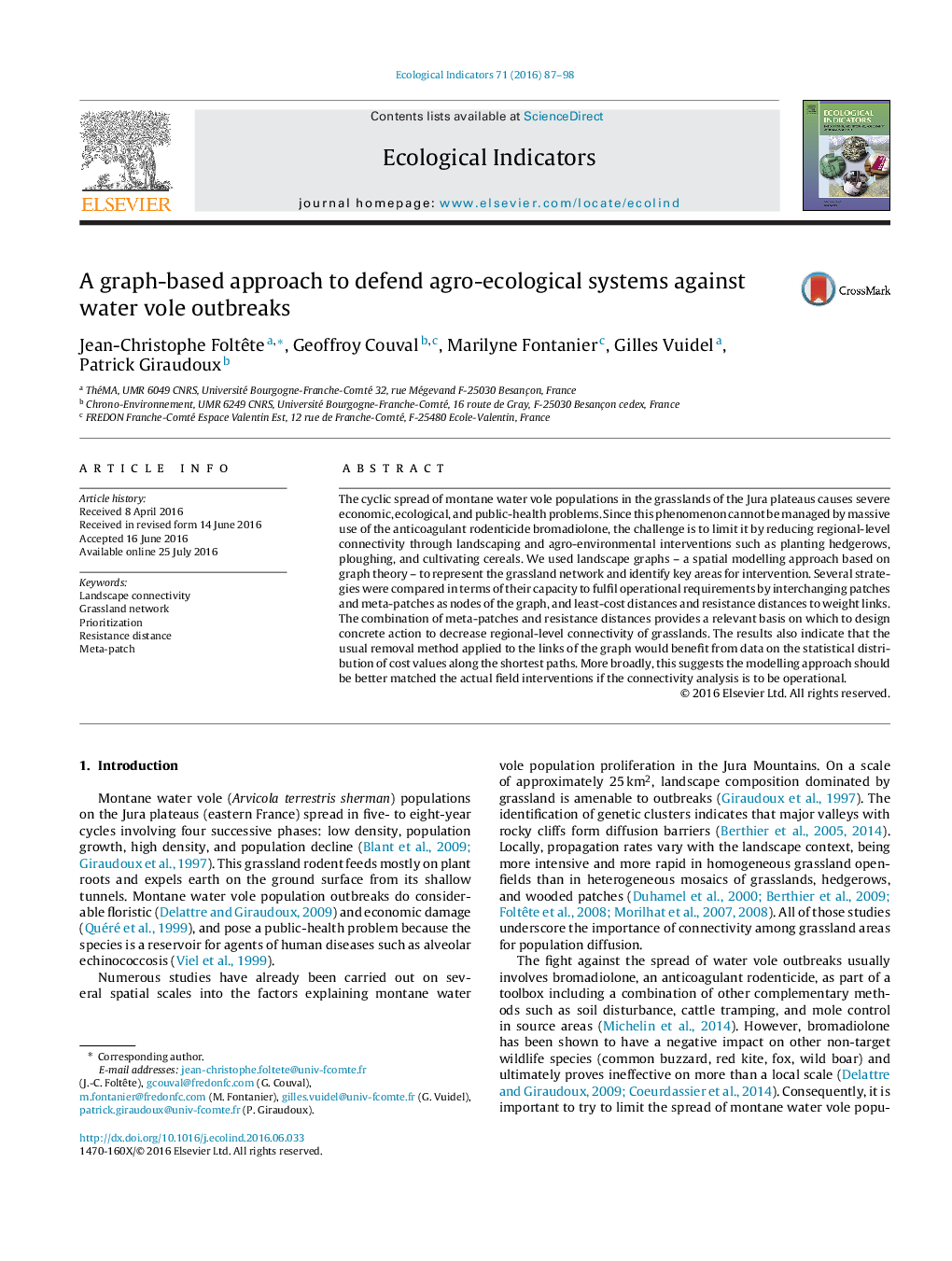| کد مقاله | کد نشریه | سال انتشار | مقاله انگلیسی | نسخه تمام متن |
|---|---|---|---|---|
| 6292906 | 1617131 | 2016 | 12 صفحه PDF | دانلود رایگان |
عنوان انگلیسی مقاله ISI
A graph-based approach to defend agro-ecological systems against water vole outbreaks
ترجمه فارسی عنوان
یک رویکرد مبتنی بر گراف برای دفاع از سیستم های زراعی و زیست محیطی در برابر شیوع آب گلدان
دانلود مقاله + سفارش ترجمه
دانلود مقاله ISI انگلیسی
رایگان برای ایرانیان
کلمات کلیدی
اتصال چشم انداز، شبکه علفزار، اولویت بندی، فاصله مقاومت، متا پچ،
ترجمه چکیده
گسترش چرخه جمعیت آب گلدان مونتان در چمنزارهای فلات جورا موجب مشکلات شدید اقتصادی، زیست محیطی و بهداشت عمومی می شود. از آنجایی که این پدیده را نمی توان با استفاده گسترده از برمودیلولون مولکولی ضد انعقادی کنترل کرد، چالش این است که با کاهش سطح اتصال منطقه ای از طریق محوطه سازی و مداخلات زراعی و محیطی مانند کاشت حوضچه ها، شخم زدن و کشت غلات، محدود شود. ما از گرافیک های چشم انداز - یک رویکرد مدل سازی فضایی بر اساس نظریه گراف استفاده کردیم تا از شبکه علفزار و شناسایی بخش های کلیدی برای مداخله استفاده کنیم. چندین استراتژی با توجه به ظرفیت آنها برای برآورده شدن نیازهای عملیاتی با تغییر پشته ها و متا تکه ها به عنوان گره های گراف، و هزینه های کمترین هزینه و فاصله مقاومت به لینک های وزن، مقایسه شد. ترکیبی از تکه های متا و فاصله های مقاومت، مبنای مربوطه را برای طراحی عملی بتن برای کاهش سطح اتصال به سطح زمین در مرتع ها فراهم می کند. نتایج همچنین نشان می دهد که روش حذف معمول برای لینک های گراف از اطلاعات مربوط به توزیع آماری ارزش های هزینه در طول کوتاه ترین مسیرها سود می برد. به طور گسترده تر، این نشان می دهد که اگر تجزیه و تحلیل ارتباطات عملیاتی شود، رویکرد مدل سازی بهتر باید با مداخلات زمینه واقعی منطبق باشد.
موضوعات مرتبط
علوم زیستی و بیوفناوری
علوم کشاورزی و بیولوژیک
بوم شناسی، تکامل، رفتار و سامانه شناسی
چکیده انگلیسی
The cyclic spread of montane water vole populations in the grasslands of the Jura plateaus causes severe economic, ecological, and public-health problems. Since this phenomenon cannot be managed by massive use of the anticoagulant rodenticide bromadiolone, the challenge is to limit it by reducing regional-level connectivity through landscaping and agro-environmental interventions such as planting hedgerows, ploughing, and cultivating cereals. We used landscape graphs - a spatial modelling approach based on graph theory - to represent the grassland network and identify key areas for intervention. Several strategies were compared in terms of their capacity to fulfil operational requirements by interchanging patches and meta-patches as nodes of the graph, and least-cost distances and resistance distances to weight links. The combination of meta-patches and resistance distances provides a relevant basis on which to design concrete action to decrease regional-level connectivity of grasslands. The results also indicate that the usual removal method applied to the links of the graph would benefit from data on the statistical distribution of cost values along the shortest paths. More broadly, this suggests the modelling approach should be better matched the actual field interventions if the connectivity analysis is to be operational.
ناشر
Database: Elsevier - ScienceDirect (ساینس دایرکت)
Journal: Ecological Indicators - Volume 71, December 2016, Pages 87-98
Journal: Ecological Indicators - Volume 71, December 2016, Pages 87-98
نویسندگان
Jean-Christophe Foltête, Geoffroy Couval, Marilyne Fontanier, Gilles Vuidel, Patrick Giraudoux,
